Competitive Strategy Analysis Report: Common Bank of Australia
VerifiedAdded on 2023/01/23
|9
|1963
|30
Report
AI Summary
This report provides a comprehensive analysis of competitive strategy tools, including PESTLE, SWOT, Porter's Five Forces, and Ansoff Matrix, applied to the case of Common Bank of Australia (CBA). The report begins with an introduction to the importance of strategic tools in business growth and outlines how management uses them to navigate uncertainties. The PESTLE analysis examines the external macro-environmental factors affecting CBA, considering political, economic, social, technological, legal, and environmental factors. The SWOT analysis identifies CBA's strengths, weaknesses, opportunities, and threats, providing a structured approach to internal and external assessments. The Porter Five Forces model evaluates the competitive forces within the banking industry, including the threat of new entrants, bargaining power of suppliers and buyers, threat of substitutes, and rivalry among existing competitors. Finally, the Ansoff Matrix is used to explore market penetration, product development, market development, and diversification strategies for CBA, providing insights into its growth potential. The report concludes by summarizing the value of these strategic tools in helping CBA gain a competitive edge and proactively respond to market dynamics.
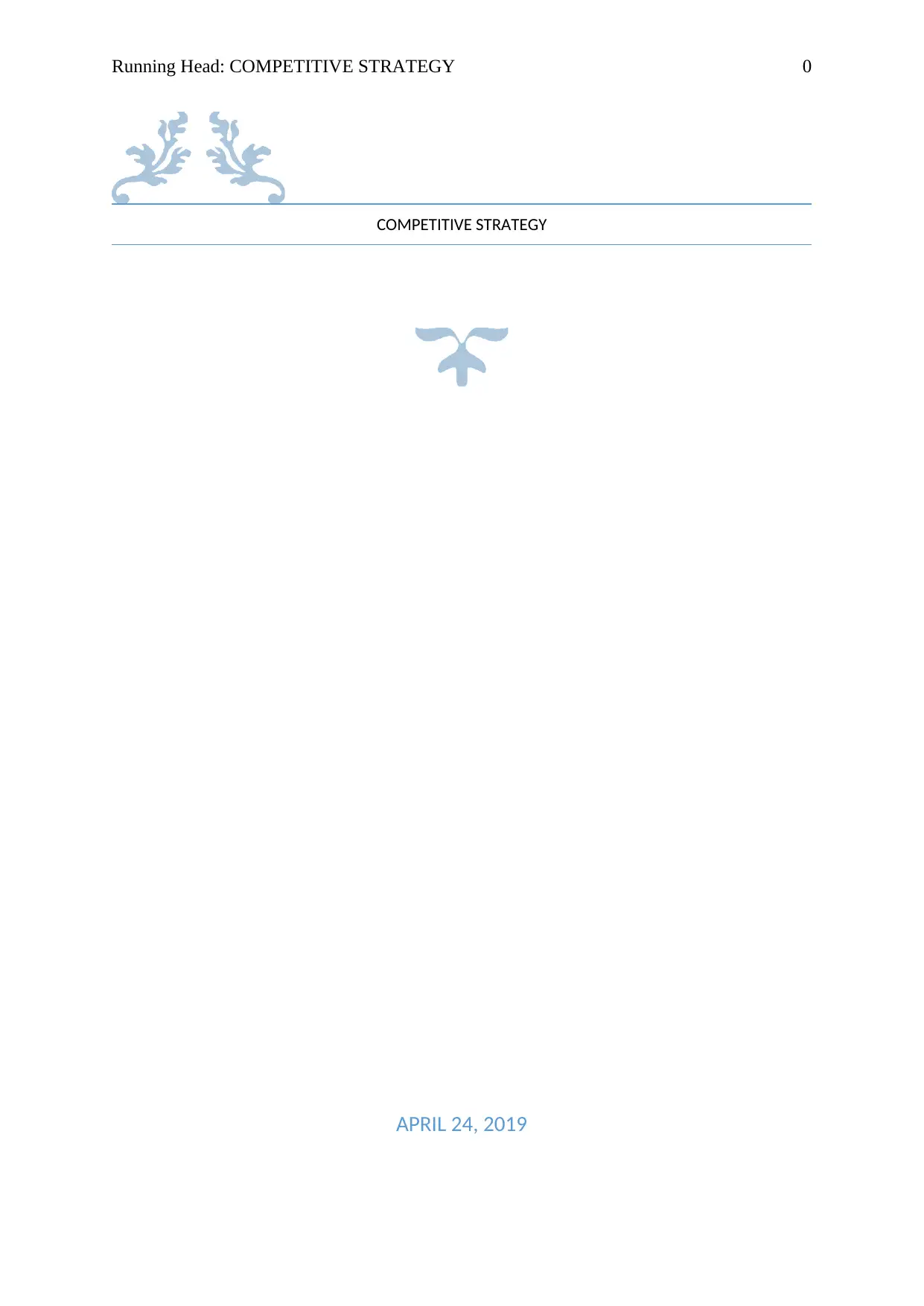
Running Head: COMPETITIVE STRATEGY 0
COMPETITIVE STRATEGY
APRIL 24, 2019
COMPETITIVE STRATEGY
APRIL 24, 2019
Paraphrase This Document
Need a fresh take? Get an instant paraphrase of this document with our AI Paraphraser
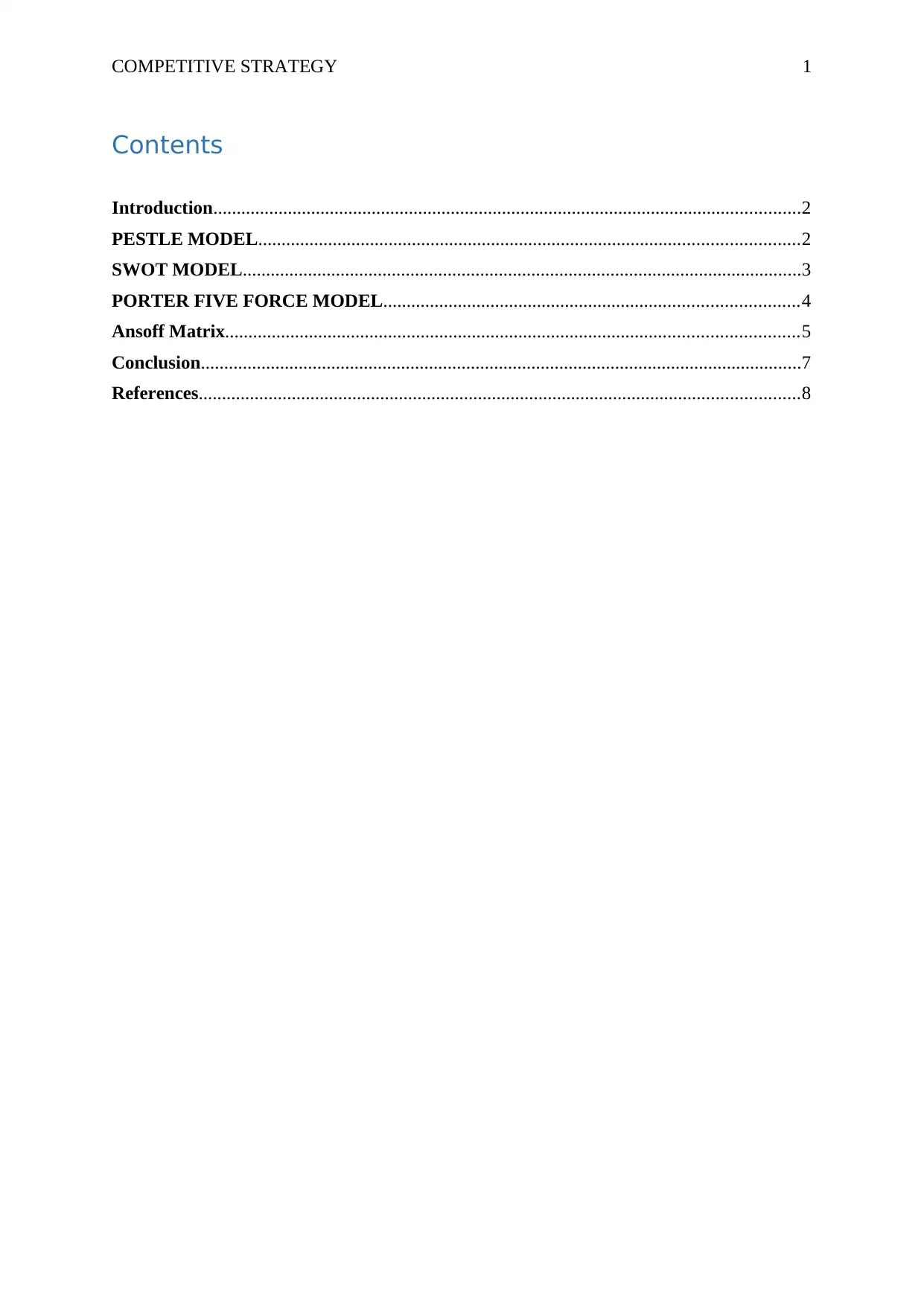
COMPETITIVE STRATEGY 1
Contents
Introduction..............................................................................................................................2
PESTLE MODEL....................................................................................................................2
SWOT MODEL........................................................................................................................3
PORTER FIVE FORCE MODEL.........................................................................................4
Ansoff Matrix...........................................................................................................................5
Conclusion.................................................................................................................................7
References.................................................................................................................................8
Contents
Introduction..............................................................................................................................2
PESTLE MODEL....................................................................................................................2
SWOT MODEL........................................................................................................................3
PORTER FIVE FORCE MODEL.........................................................................................4
Ansoff Matrix...........................................................................................................................5
Conclusion.................................................................................................................................7
References.................................................................................................................................8
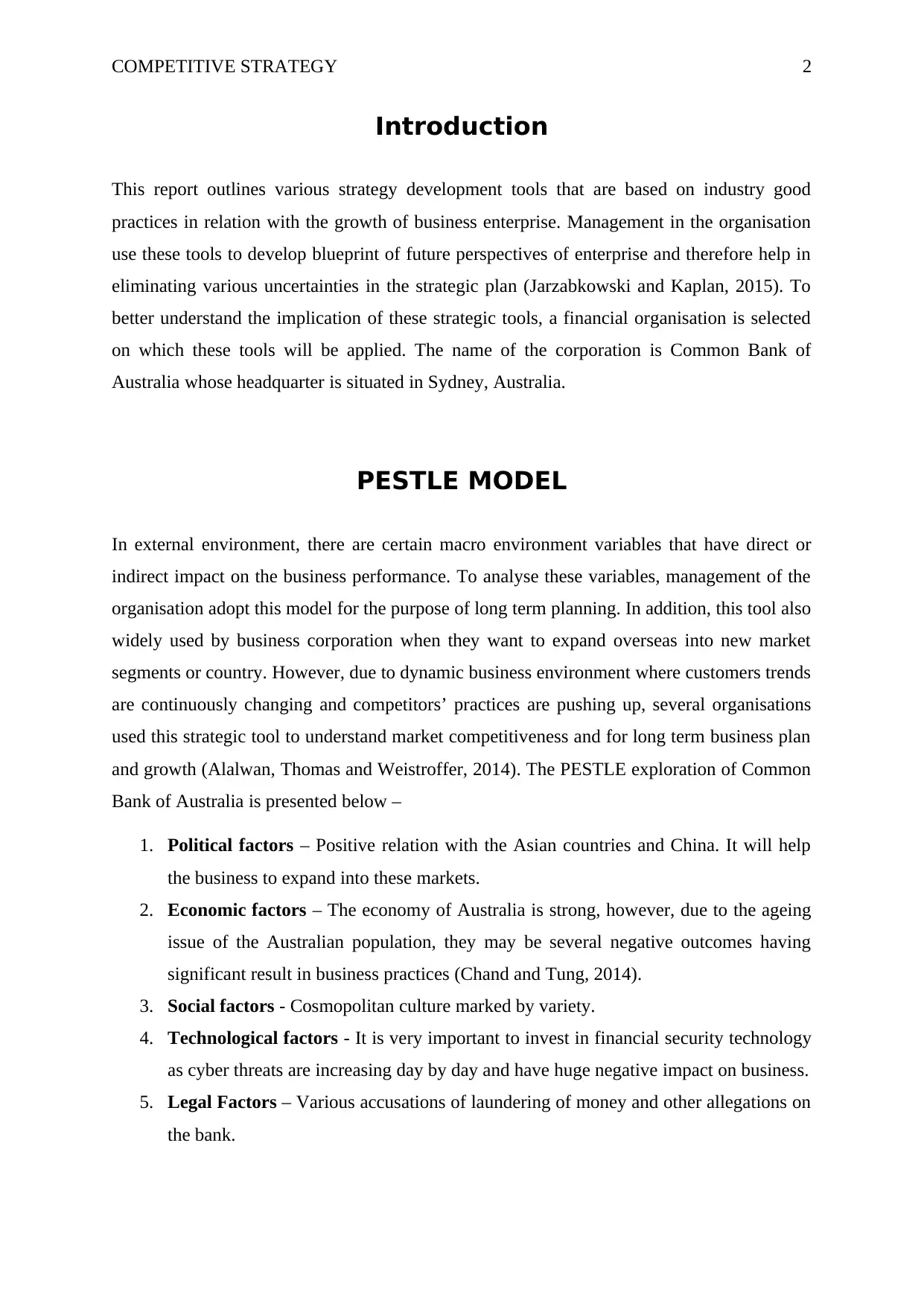
COMPETITIVE STRATEGY 2
Introduction
This report outlines various strategy development tools that are based on industry good
practices in relation with the growth of business enterprise. Management in the organisation
use these tools to develop blueprint of future perspectives of enterprise and therefore help in
eliminating various uncertainties in the strategic plan (Jarzabkowski and Kaplan, 2015). To
better understand the implication of these strategic tools, a financial organisation is selected
on which these tools will be applied. The name of the corporation is Common Bank of
Australia whose headquarter is situated in Sydney, Australia.
PESTLE MODEL
In external environment, there are certain macro environment variables that have direct or
indirect impact on the business performance. To analyse these variables, management of the
organisation adopt this model for the purpose of long term planning. In addition, this tool also
widely used by business corporation when they want to expand overseas into new market
segments or country. However, due to dynamic business environment where customers trends
are continuously changing and competitors’ practices are pushing up, several organisations
used this strategic tool to understand market competitiveness and for long term business plan
and growth (Alalwan, Thomas and Weistroffer, 2014). The PESTLE exploration of Common
Bank of Australia is presented below –
1. Political factors – Positive relation with the Asian countries and China. It will help
the business to expand into these markets.
2. Economic factors – The economy of Australia is strong, however, due to the ageing
issue of the Australian population, they may be several negative outcomes having
significant result in business practices (Chand and Tung, 2014).
3. Social factors - Cosmopolitan culture marked by variety.
4. Technological factors - It is very important to invest in financial security technology
as cyber threats are increasing day by day and have huge negative impact on business.
5. Legal Factors – Various accusations of laundering of money and other allegations on
the bank.
Introduction
This report outlines various strategy development tools that are based on industry good
practices in relation with the growth of business enterprise. Management in the organisation
use these tools to develop blueprint of future perspectives of enterprise and therefore help in
eliminating various uncertainties in the strategic plan (Jarzabkowski and Kaplan, 2015). To
better understand the implication of these strategic tools, a financial organisation is selected
on which these tools will be applied. The name of the corporation is Common Bank of
Australia whose headquarter is situated in Sydney, Australia.
PESTLE MODEL
In external environment, there are certain macro environment variables that have direct or
indirect impact on the business performance. To analyse these variables, management of the
organisation adopt this model for the purpose of long term planning. In addition, this tool also
widely used by business corporation when they want to expand overseas into new market
segments or country. However, due to dynamic business environment where customers trends
are continuously changing and competitors’ practices are pushing up, several organisations
used this strategic tool to understand market competitiveness and for long term business plan
and growth (Alalwan, Thomas and Weistroffer, 2014). The PESTLE exploration of Common
Bank of Australia is presented below –
1. Political factors – Positive relation with the Asian countries and China. It will help
the business to expand into these markets.
2. Economic factors – The economy of Australia is strong, however, due to the ageing
issue of the Australian population, they may be several negative outcomes having
significant result in business practices (Chand and Tung, 2014).
3. Social factors - Cosmopolitan culture marked by variety.
4. Technological factors - It is very important to invest in financial security technology
as cyber threats are increasing day by day and have huge negative impact on business.
5. Legal Factors – Various accusations of laundering of money and other allegations on
the bank.
⊘ This is a preview!⊘
Do you want full access?
Subscribe today to unlock all pages.

Trusted by 1+ million students worldwide
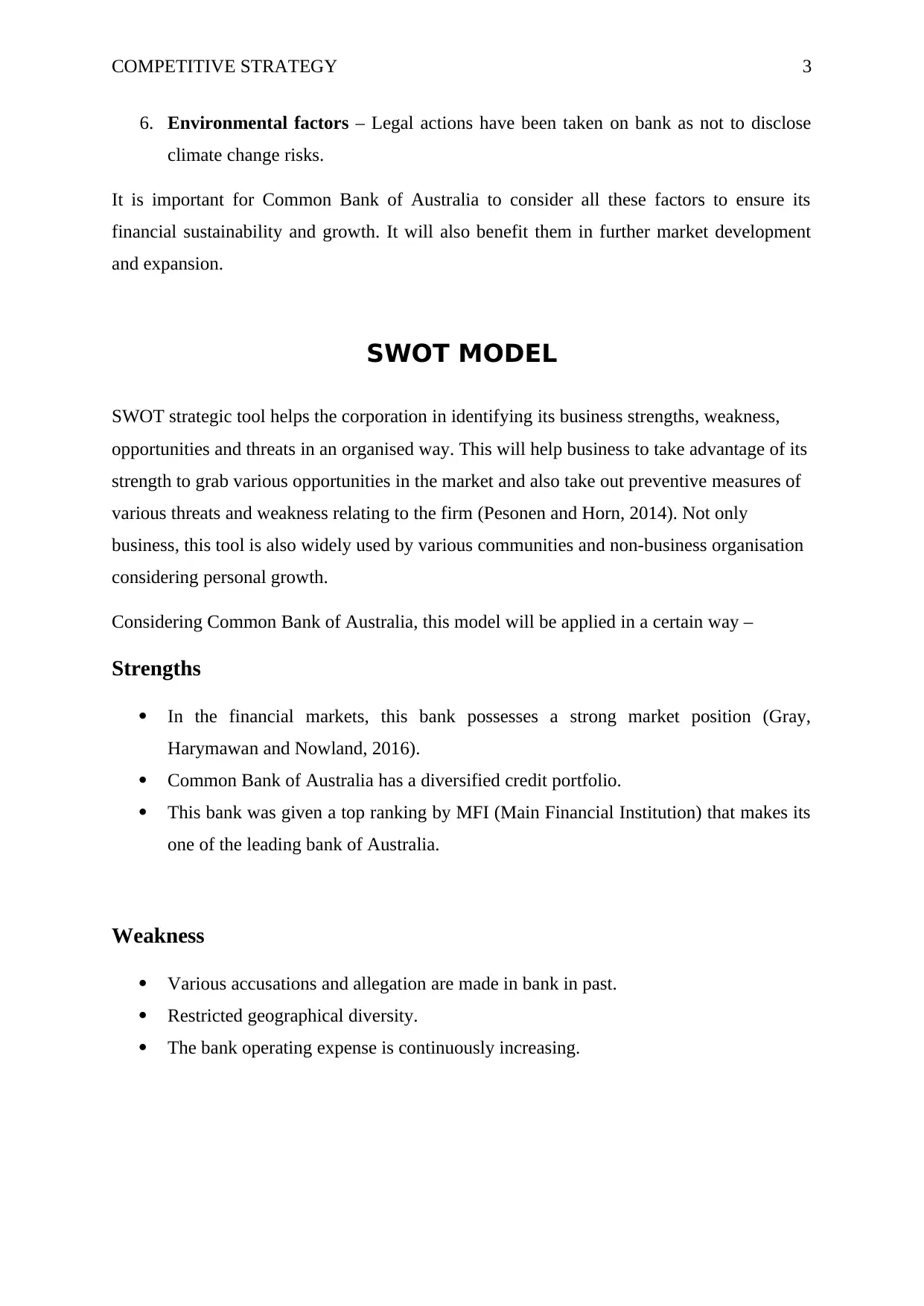
COMPETITIVE STRATEGY 3
6. Environmental factors – Legal actions have been taken on bank as not to disclose
climate change risks.
It is important for Common Bank of Australia to consider all these factors to ensure its
financial sustainability and growth. It will also benefit them in further market development
and expansion.
SWOT MODEL
SWOT strategic tool helps the corporation in identifying its business strengths, weakness,
opportunities and threats in an organised way. This will help business to take advantage of its
strength to grab various opportunities in the market and also take out preventive measures of
various threats and weakness relating to the firm (Pesonen and Horn, 2014). Not only
business, this tool is also widely used by various communities and non-business organisation
considering personal growth.
Considering Common Bank of Australia, this model will be applied in a certain way –
Strengths
In the financial markets, this bank possesses a strong market position (Gray,
Harymawan and Nowland, 2016).
Common Bank of Australia has a diversified credit portfolio.
This bank was given a top ranking by MFI (Main Financial Institution) that makes its
one of the leading bank of Australia.
Weakness
Various accusations and allegation are made in bank in past.
Restricted geographical diversity.
The bank operating expense is continuously increasing.
6. Environmental factors – Legal actions have been taken on bank as not to disclose
climate change risks.
It is important for Common Bank of Australia to consider all these factors to ensure its
financial sustainability and growth. It will also benefit them in further market development
and expansion.
SWOT MODEL
SWOT strategic tool helps the corporation in identifying its business strengths, weakness,
opportunities and threats in an organised way. This will help business to take advantage of its
strength to grab various opportunities in the market and also take out preventive measures of
various threats and weakness relating to the firm (Pesonen and Horn, 2014). Not only
business, this tool is also widely used by various communities and non-business organisation
considering personal growth.
Considering Common Bank of Australia, this model will be applied in a certain way –
Strengths
In the financial markets, this bank possesses a strong market position (Gray,
Harymawan and Nowland, 2016).
Common Bank of Australia has a diversified credit portfolio.
This bank was given a top ranking by MFI (Main Financial Institution) that makes its
one of the leading bank of Australia.
Weakness
Various accusations and allegation are made in bank in past.
Restricted geographical diversity.
The bank operating expense is continuously increasing.
Paraphrase This Document
Need a fresh take? Get an instant paraphrase of this document with our AI Paraphraser
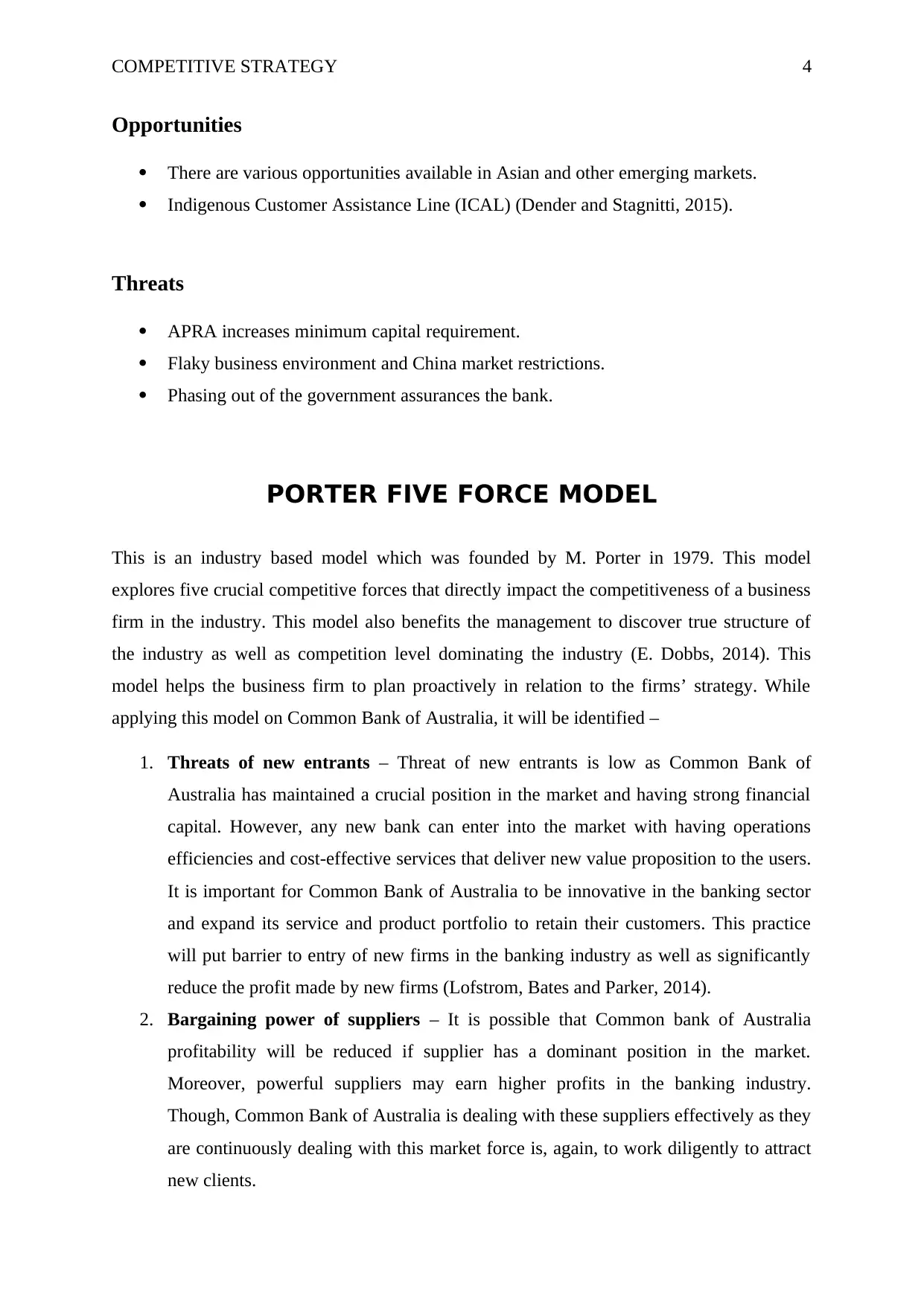
COMPETITIVE STRATEGY 4
Opportunities
There are various opportunities available in Asian and other emerging markets.
Indigenous Customer Assistance Line (ICAL) (Dender and Stagnitti, 2015).
Threats
APRA increases minimum capital requirement.
Flaky business environment and China market restrictions.
Phasing out of the government assurances the bank.
PORTER FIVE FORCE MODEL
This is an industry based model which was founded by M. Porter in 1979. This model
explores five crucial competitive forces that directly impact the competitiveness of a business
firm in the industry. This model also benefits the management to discover true structure of
the industry as well as competition level dominating the industry (E. Dobbs, 2014). This
model helps the business firm to plan proactively in relation to the firms’ strategy. While
applying this model on Common Bank of Australia, it will be identified –
1. Threats of new entrants – Threat of new entrants is low as Common Bank of
Australia has maintained a crucial position in the market and having strong financial
capital. However, any new bank can enter into the market with having operations
efficiencies and cost-effective services that deliver new value proposition to the users.
It is important for Common Bank of Australia to be innovative in the banking sector
and expand its service and product portfolio to retain their customers. This practice
will put barrier to entry of new firms in the banking industry as well as significantly
reduce the profit made by new firms (Lofstrom, Bates and Parker, 2014).
2. Bargaining power of suppliers – It is possible that Common bank of Australia
profitability will be reduced if supplier has a dominant position in the market.
Moreover, powerful suppliers may earn higher profits in the banking industry.
Though, Common Bank of Australia is dealing with these suppliers effectively as they
are continuously dealing with this market force is, again, to work diligently to attract
new clients.
Opportunities
There are various opportunities available in Asian and other emerging markets.
Indigenous Customer Assistance Line (ICAL) (Dender and Stagnitti, 2015).
Threats
APRA increases minimum capital requirement.
Flaky business environment and China market restrictions.
Phasing out of the government assurances the bank.
PORTER FIVE FORCE MODEL
This is an industry based model which was founded by M. Porter in 1979. This model
explores five crucial competitive forces that directly impact the competitiveness of a business
firm in the industry. This model also benefits the management to discover true structure of
the industry as well as competition level dominating the industry (E. Dobbs, 2014). This
model helps the business firm to plan proactively in relation to the firms’ strategy. While
applying this model on Common Bank of Australia, it will be identified –
1. Threats of new entrants – Threat of new entrants is low as Common Bank of
Australia has maintained a crucial position in the market and having strong financial
capital. However, any new bank can enter into the market with having operations
efficiencies and cost-effective services that deliver new value proposition to the users.
It is important for Common Bank of Australia to be innovative in the banking sector
and expand its service and product portfolio to retain their customers. This practice
will put barrier to entry of new firms in the banking industry as well as significantly
reduce the profit made by new firms (Lofstrom, Bates and Parker, 2014).
2. Bargaining power of suppliers – It is possible that Common bank of Australia
profitability will be reduced if supplier has a dominant position in the market.
Moreover, powerful suppliers may earn higher profits in the banking industry.
Though, Common Bank of Australia is dealing with these suppliers effectively as they
are continuously dealing with this market force is, again, to work diligently to attract
new clients.
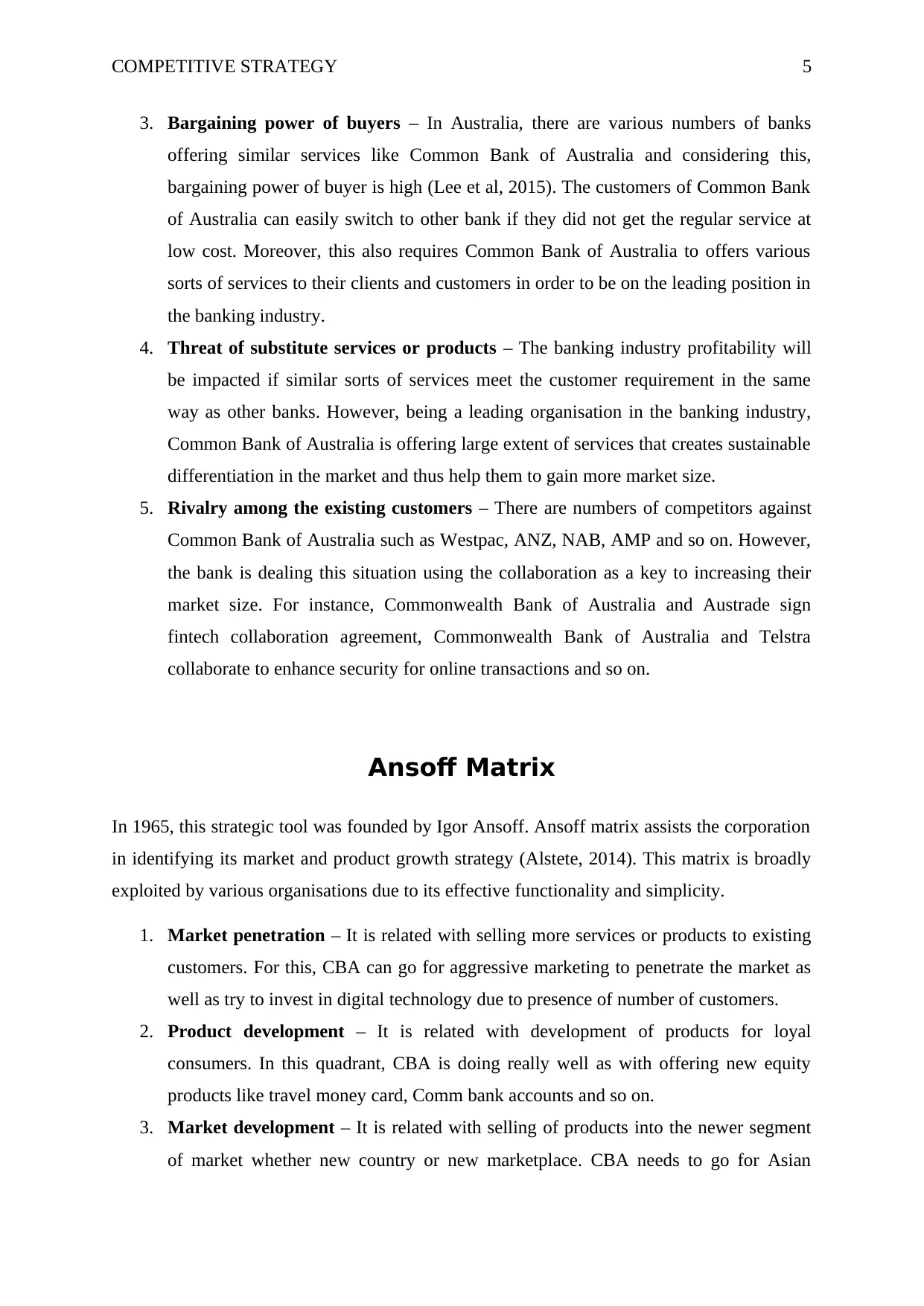
COMPETITIVE STRATEGY 5
3. Bargaining power of buyers – In Australia, there are various numbers of banks
offering similar services like Common Bank of Australia and considering this,
bargaining power of buyer is high (Lee et al, 2015). The customers of Common Bank
of Australia can easily switch to other bank if they did not get the regular service at
low cost. Moreover, this also requires Common Bank of Australia to offers various
sorts of services to their clients and customers in order to be on the leading position in
the banking industry.
4. Threat of substitute services or products – The banking industry profitability will
be impacted if similar sorts of services meet the customer requirement in the same
way as other banks. However, being a leading organisation in the banking industry,
Common Bank of Australia is offering large extent of services that creates sustainable
differentiation in the market and thus help them to gain more market size.
5. Rivalry among the existing customers – There are numbers of competitors against
Common Bank of Australia such as Westpac, ANZ, NAB, AMP and so on. However,
the bank is dealing this situation using the collaboration as a key to increasing their
market size. For instance, Commonwealth Bank of Australia and Austrade sign
fintech collaboration agreement, Commonwealth Bank of Australia and Telstra
collaborate to enhance security for online transactions and so on.
Ansoff Matrix
In 1965, this strategic tool was founded by Igor Ansoff. Ansoff matrix assists the corporation
in identifying its market and product growth strategy (Alstete, 2014). This matrix is broadly
exploited by various organisations due to its effective functionality and simplicity.
1. Market penetration – It is related with selling more services or products to existing
customers. For this, CBA can go for aggressive marketing to penetrate the market as
well as try to invest in digital technology due to presence of number of customers.
2. Product development – It is related with development of products for loyal
consumers. In this quadrant, CBA is doing really well as with offering new equity
products like travel money card, Comm bank accounts and so on.
3. Market development – It is related with selling of products into the newer segment
of market whether new country or new marketplace. CBA needs to go for Asian
3. Bargaining power of buyers – In Australia, there are various numbers of banks
offering similar services like Common Bank of Australia and considering this,
bargaining power of buyer is high (Lee et al, 2015). The customers of Common Bank
of Australia can easily switch to other bank if they did not get the regular service at
low cost. Moreover, this also requires Common Bank of Australia to offers various
sorts of services to their clients and customers in order to be on the leading position in
the banking industry.
4. Threat of substitute services or products – The banking industry profitability will
be impacted if similar sorts of services meet the customer requirement in the same
way as other banks. However, being a leading organisation in the banking industry,
Common Bank of Australia is offering large extent of services that creates sustainable
differentiation in the market and thus help them to gain more market size.
5. Rivalry among the existing customers – There are numbers of competitors against
Common Bank of Australia such as Westpac, ANZ, NAB, AMP and so on. However,
the bank is dealing this situation using the collaboration as a key to increasing their
market size. For instance, Commonwealth Bank of Australia and Austrade sign
fintech collaboration agreement, Commonwealth Bank of Australia and Telstra
collaborate to enhance security for online transactions and so on.
Ansoff Matrix
In 1965, this strategic tool was founded by Igor Ansoff. Ansoff matrix assists the corporation
in identifying its market and product growth strategy (Alstete, 2014). This matrix is broadly
exploited by various organisations due to its effective functionality and simplicity.
1. Market penetration – It is related with selling more services or products to existing
customers. For this, CBA can go for aggressive marketing to penetrate the market as
well as try to invest in digital technology due to presence of number of customers.
2. Product development – It is related with development of products for loyal
consumers. In this quadrant, CBA is doing really well as with offering new equity
products like travel money card, Comm bank accounts and so on.
3. Market development – It is related with selling of products into the newer segment
of market whether new country or new marketplace. CBA needs to go for Asian
⊘ This is a preview!⊘
Do you want full access?
Subscribe today to unlock all pages.

Trusted by 1+ million students worldwide
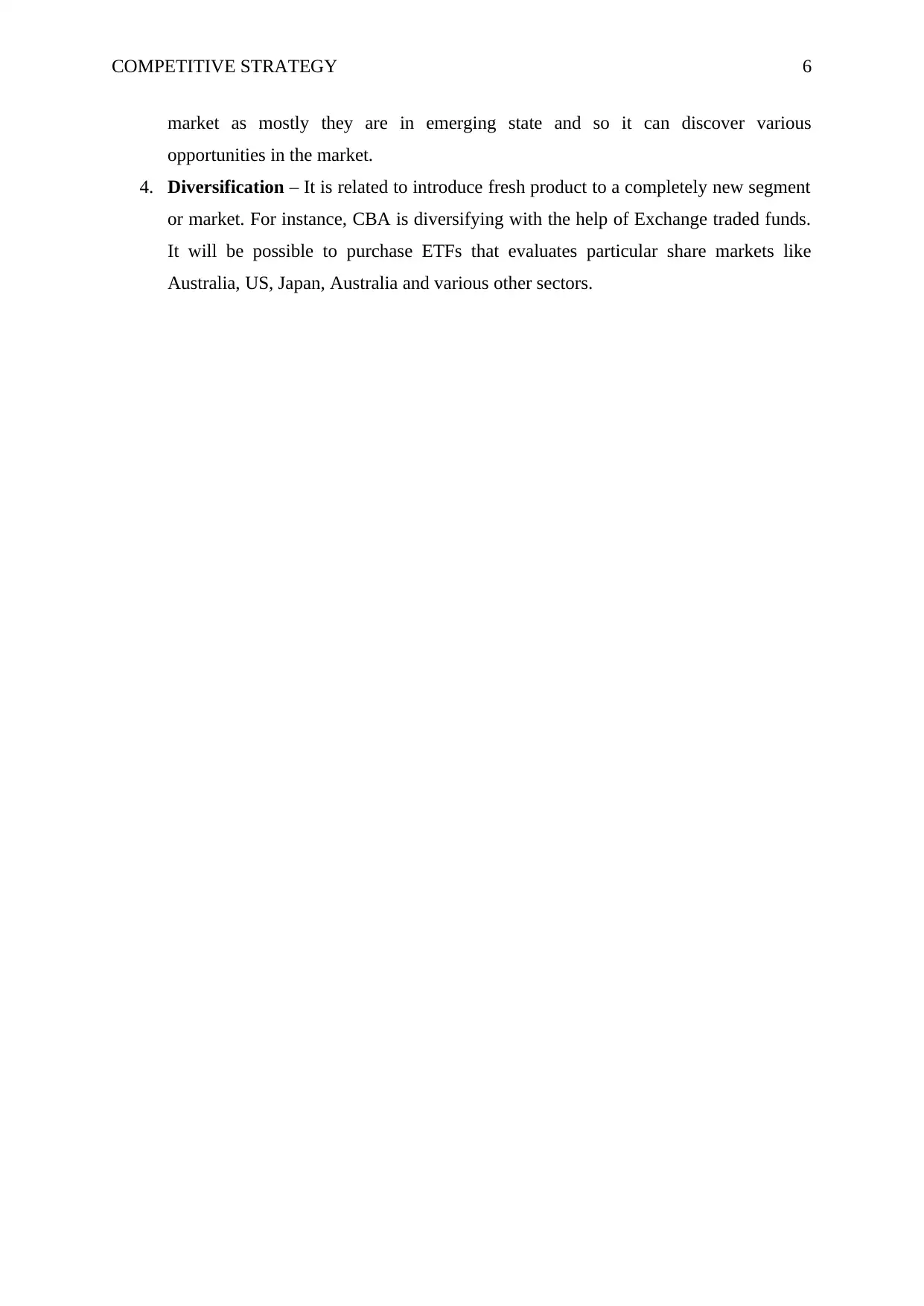
COMPETITIVE STRATEGY 6
market as mostly they are in emerging state and so it can discover various
opportunities in the market.
4. Diversification – It is related to introduce fresh product to a completely new segment
or market. For instance, CBA is diversifying with the help of Exchange traded funds.
It will be possible to purchase ETFs that evaluates particular share markets like
Australia, US, Japan, Australia and various other sectors.
market as mostly they are in emerging state and so it can discover various
opportunities in the market.
4. Diversification – It is related to introduce fresh product to a completely new segment
or market. For instance, CBA is diversifying with the help of Exchange traded funds.
It will be possible to purchase ETFs that evaluates particular share markets like
Australia, US, Japan, Australia and various other sectors.
Paraphrase This Document
Need a fresh take? Get an instant paraphrase of this document with our AI Paraphraser
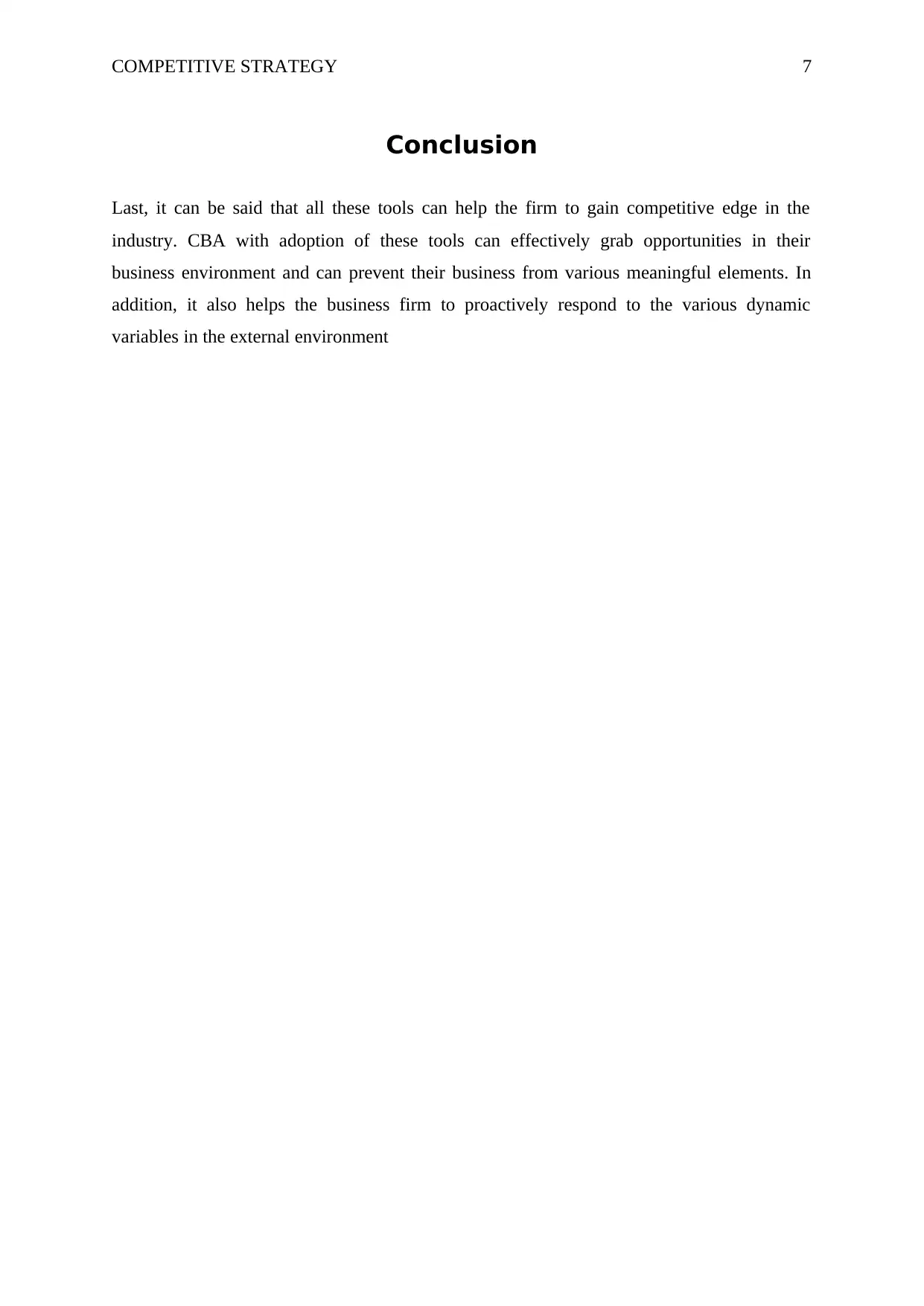
COMPETITIVE STRATEGY 7
Conclusion
Last, it can be said that all these tools can help the firm to gain competitive edge in the
industry. CBA with adoption of these tools can effectively grab opportunities in their
business environment and can prevent their business from various meaningful elements. In
addition, it also helps the business firm to proactively respond to the various dynamic
variables in the external environment
Conclusion
Last, it can be said that all these tools can help the firm to gain competitive edge in the
industry. CBA with adoption of these tools can effectively grab opportunities in their
business environment and can prevent their business from various meaningful elements. In
addition, it also helps the business firm to proactively respond to the various dynamic
variables in the external environment
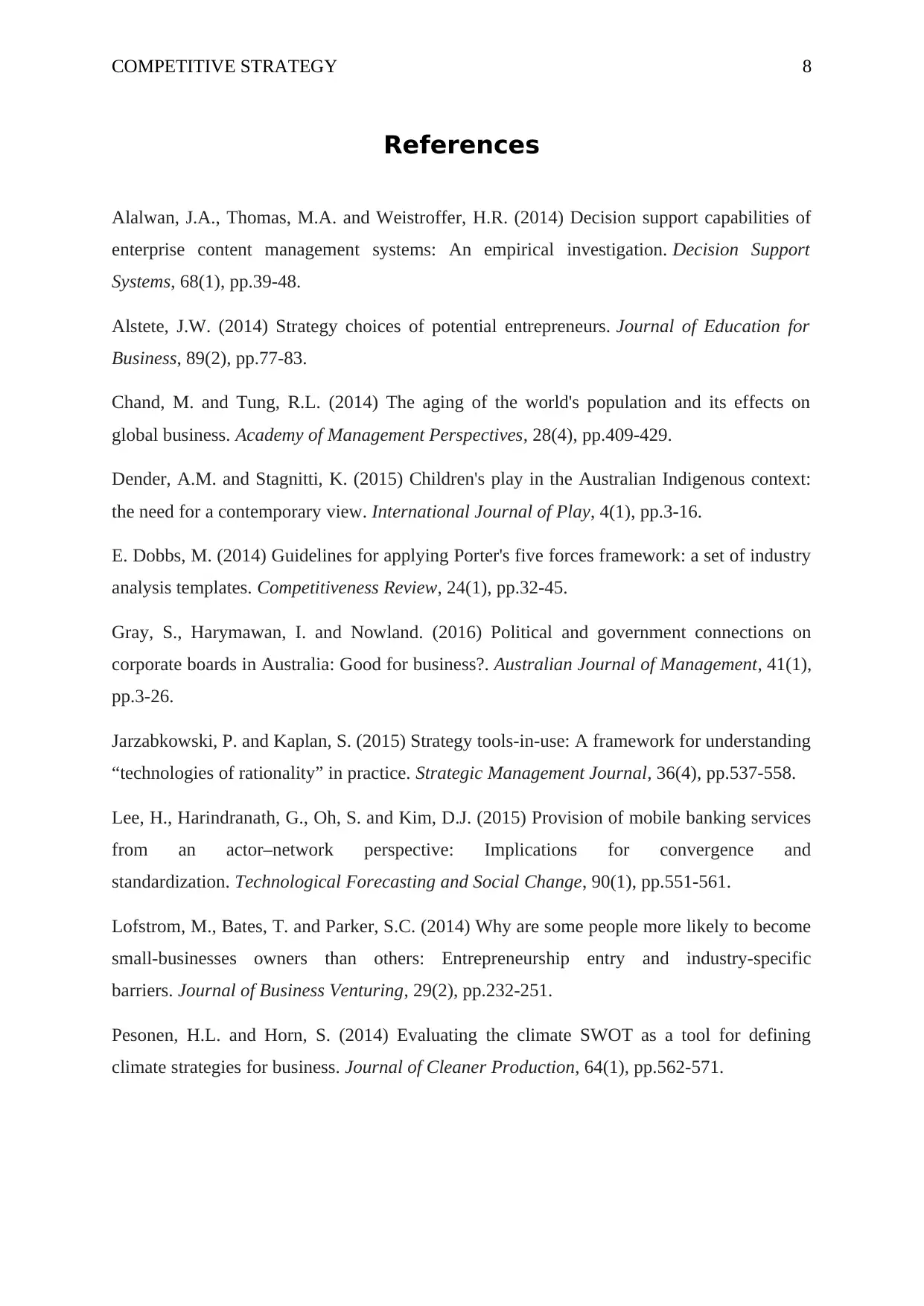
COMPETITIVE STRATEGY 8
References
Alalwan, J.A., Thomas, M.A. and Weistroffer, H.R. (2014) Decision support capabilities of
enterprise content management systems: An empirical investigation. Decision Support
Systems, 68(1), pp.39-48.
Alstete, J.W. (2014) Strategy choices of potential entrepreneurs. Journal of Education for
Business, 89(2), pp.77-83.
Chand, M. and Tung, R.L. (2014) The aging of the world's population and its effects on
global business. Academy of Management Perspectives, 28(4), pp.409-429.
Dender, A.M. and Stagnitti, K. (2015) Children's play in the Australian Indigenous context:
the need for a contemporary view. International Journal of Play, 4(1), pp.3-16.
E. Dobbs, M. (2014) Guidelines for applying Porter's five forces framework: a set of industry
analysis templates. Competitiveness Review, 24(1), pp.32-45.
Gray, S., Harymawan, I. and Nowland. (2016) Political and government connections on
corporate boards in Australia: Good for business?. Australian Journal of Management, 41(1),
pp.3-26.
Jarzabkowski, P. and Kaplan, S. (2015) Strategy tools‐in‐use: A framework for understanding
“technologies of rationality” in practice. Strategic Management Journal, 36(4), pp.537-558.
Lee, H., Harindranath, G., Oh, S. and Kim, D.J. (2015) Provision of mobile banking services
from an actor–network perspective: Implications for convergence and
standardization. Technological Forecasting and Social Change, 90(1), pp.551-561.
Lofstrom, M., Bates, T. and Parker, S.C. (2014) Why are some people more likely to become
small-businesses owners than others: Entrepreneurship entry and industry-specific
barriers. Journal of Business Venturing, 29(2), pp.232-251.
Pesonen, H.L. and Horn, S. (2014) Evaluating the climate SWOT as a tool for defining
climate strategies for business. Journal of Cleaner Production, 64(1), pp.562-571.
References
Alalwan, J.A., Thomas, M.A. and Weistroffer, H.R. (2014) Decision support capabilities of
enterprise content management systems: An empirical investigation. Decision Support
Systems, 68(1), pp.39-48.
Alstete, J.W. (2014) Strategy choices of potential entrepreneurs. Journal of Education for
Business, 89(2), pp.77-83.
Chand, M. and Tung, R.L. (2014) The aging of the world's population and its effects on
global business. Academy of Management Perspectives, 28(4), pp.409-429.
Dender, A.M. and Stagnitti, K. (2015) Children's play in the Australian Indigenous context:
the need for a contemporary view. International Journal of Play, 4(1), pp.3-16.
E. Dobbs, M. (2014) Guidelines for applying Porter's five forces framework: a set of industry
analysis templates. Competitiveness Review, 24(1), pp.32-45.
Gray, S., Harymawan, I. and Nowland. (2016) Political and government connections on
corporate boards in Australia: Good for business?. Australian Journal of Management, 41(1),
pp.3-26.
Jarzabkowski, P. and Kaplan, S. (2015) Strategy tools‐in‐use: A framework for understanding
“technologies of rationality” in practice. Strategic Management Journal, 36(4), pp.537-558.
Lee, H., Harindranath, G., Oh, S. and Kim, D.J. (2015) Provision of mobile banking services
from an actor–network perspective: Implications for convergence and
standardization. Technological Forecasting and Social Change, 90(1), pp.551-561.
Lofstrom, M., Bates, T. and Parker, S.C. (2014) Why are some people more likely to become
small-businesses owners than others: Entrepreneurship entry and industry-specific
barriers. Journal of Business Venturing, 29(2), pp.232-251.
Pesonen, H.L. and Horn, S. (2014) Evaluating the climate SWOT as a tool for defining
climate strategies for business. Journal of Cleaner Production, 64(1), pp.562-571.
⊘ This is a preview!⊘
Do you want full access?
Subscribe today to unlock all pages.

Trusted by 1+ million students worldwide
1 out of 9
Related Documents
Your All-in-One AI-Powered Toolkit for Academic Success.
+13062052269
info@desklib.com
Available 24*7 on WhatsApp / Email
![[object Object]](/_next/static/media/star-bottom.7253800d.svg)
Unlock your academic potential
Copyright © 2020–2025 A2Z Services. All Rights Reserved. Developed and managed by ZUCOL.




